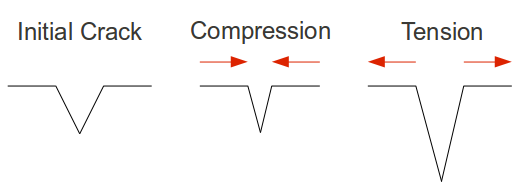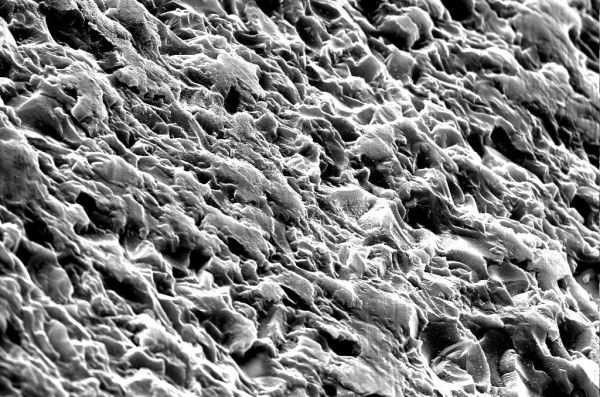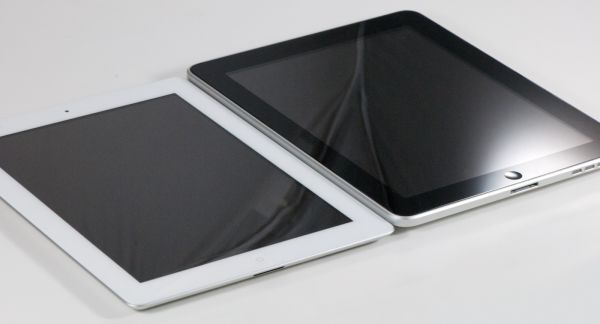The Apple iPad 2 Review
by Brian Klug, Anand Lal Shimpi & Vivek Gowri on March 19, 2011 8:01 PM ESTI asked a friend of mine, Alexander Miles, to write a bit about the properties of glass that really contribute to its overall strength after reading that the iPad 2's glass is 0.62 mm thick compared to 0.85 mm thick in the iPad 1. Hopefully this dispels some myths about glass strength and clarifies. Alex is a senior double majoring in Materials Science and Engineering and Optical Science and Engineering at the University of Arizona.
On the Strength of Glass
We usually think of things failing under compressive stress, being pushed inward from both sides until it they are crushed. Glass and ceramics, it turns out, are incredibly strong in compressive stress. Strictly by the numbers, a fire truck could be supported by a ceramic coffee cup underneath each tire, but only if the load was perfectly downward. Why then are glasses so fragile? This is because no situation causes only compressive stresses, and tensile stress (imagine pulling something from both ends) is what causes glasses to fail. One can think of tiny cracks inside the glass being pushed closed under compressive stress, but torn open under tensile stress.

A schematic illustration of crack behavior in brittle materials.
If you test the tensile strength of thousands of pieces of glass with identical processing and geometry, you will get thousands of different answers. This is markedly different from metals, where you will get nearly the same result every time. The reason being that glass and ceramic materials have a much lower fracture toughness, as much as 100 times smaller than that of a metal. Fracture toughness indicates how easily a crack can propagate, or to phrase it differently, how big a flaw will cause fracture for a given load. As the required load for normal flaw sizes in metals is enormous, metals typically do not fracture in the way glasses do. Metals usually fail in what is called plastic deformation, necking down then tearing away, long before fracture can occur. This plastic deformation is very predictable and follows the stress-strain curve for the given metal, whereas glasses are less predictable.
The question now is, how does the size of a piece of glass affect its behavior under tensile stress? It depends on the distribution of flaws within the material. If you strike a piece of glass with a hammer, a compressive stress is created right below the hammer, but a ring of tensile stress is also created around the spot you hit. You are essentially sampling the distribution of flaws, because if any of the flaws in the affected glass are big enough to widen with the stress you provided, they will rapidly propagate and the material will fracture. The stress field extends down into he material, so flaws in the volume can cause failure as well, though surface flaws are more consistently to blame as the stresses encountered there are almost always larger.

SEM image of a broken glass surface, (CC BY-NC-ND 2.0) attribution St Stev's flickr.
In glasses the distribution of failure stresses is described using Weibull statistics, giving a peak where most samples fail, and tails both on the high and low end where samples had abnormally high and low failure stresses respectively. The long and short of this is that consistently processed samples will have a more narrow distribution as the geometries are scaled down. This means that a thinner piece of glass will have fewer flaws in the bulk and far less likelihood of having a large enough flaw to cause catastrophic failure compared to a thicker piece of glass. The fact that the screens have a large aspect ratio, that is they are far thinner than they are wide or long, means that the effective stiffness will be different in the two directions. Taking this to an extreme, a very thin glass fiber is fairly flexible in bending, but very stiff axially, as its cross-section is so small that very few flaws are contained inside it. If one needs to break a glass fiber, a surface flaw is usually created by scratching it first.
| Approximate values for the strength of common soda lime glass in various conditions | |||||
| Condition | Tensile Strength (MPa) | ||||
| Theoretical Maximum (Flawless) | 9810 | ||||
| 3 Micron Fibers | 3330 | ||||
| Thin rods, fire-polished and acid etched | 3420 | ||||
| Thin rods, no special treatment | 690 | ||||
| Bulk, ion exchange tempered | 350 | ||||
| Bulk, thermally tempered | 300 | ||||
| Bulk, fire-polished and acid etched | 220 | ||||
| Bulk, no special treatment | 50 | ||||
In order to use glass screens on our devices, we would like it to be far tougher, where "tougher'' ideally means both more resistant to fracture as well as more resistant to scratching. There are two basic schemes used to strengthen glass: elimination of the surface flaws, and creation of compressive stress in the bulk of the glass. Eliminating the surface flaws by polishing, fire-polishing (heating them until surface tension flattens out the flaws), and acid-etching does indeed increase the strength, and drastically so. An increase in strength of up to one hundred times can result from such treatment, but is temporary as microscopic scratches from handling will quickly reduce the strength back to what it was before.
The second scheme for improving strength, introducing a compressive layer, works because existing compressive stress in the glass has to be overcome by the induced tensile stress before any cracks can propagate. To say it plainly, if you don't hit it hard enough with a hammer, it will not even see the type of stress that makes it fail. The down side to this method is that every force causes an equal and opposite force, meaning that a lot of compression at the surface causes tension at the center. As long as a crack does not reach the volume with the additional tensile stress imposed on it, the glass will hold together, but once it does it releases the energy kinetically and fails catastrophically (it explodes like a pumpkin with an M80 stuffed in it).
The way this layer is created varies based on the application. For car windshields, they are thermally tempered by chilling the outer surface while the center is still hot, as the surface remains solid while the center is still busy shrinking, which leaves the surface in compression. Similarly, coating the glass object in a second type of glass with a lower thermal expansion will cause the same effect, as the outer surface shrinks the center is shrinking faster. The multiple-glass approach has the additional benefit that cracks have difficultly moving from one type of glass to the next, leading Corning to produce some glasses with as many as 7 layers.
The final method, and most relevant to our discussion, is ion-exchange. Ion-exchange refers to removing small ions, like sodium, from the glass, and replacing them with larger ions like potassium, all at a temperature that prevents the structure of the glass from adjusting itself to these new bigger ions. The way this swap is actually done is by immersing the glass in a molten salt solution containing the ion we want to substitute in, and allowing it to diffuse in over time, while the smaller, more mobile, ion diffuses out. Depending upon the type of glass, the ions being exchanged, and the desired depth, this process can take as long as several days.
The iPad 2 and previous iPad both utilize Corning Gorilla Glass. This type of glass is an alkali-aluminosilicate, being primarily silica and aluminum with an alkali metal, along with other unspecified components mixed in to tweak its properties. The biggest benefit of alluminosilicate glasses, aside from being relatively tough to start with, is the fact that the rate of ion exchange is fairly high even at temperatures low enough that the structure cannot react, meaning it can be processed quickly and create deep protective layers in the glass. The iPad 2 has a modest reduction in the thickness of the glass (about 23% thinner, for those interested) compared to the first iPad, and the question of increased fracture risk has been posed. Given the identical surface quality between the two generations, the reduction of thickness should create no palpable change in toughness for the typical user. That is to say, a drop that would shatter the screen on the original iPad would likely do the same for the new model. That being said, several other design changes appear to account for the change, and might yield better performance in this department.
Where its predecessor used small metal clips to retain the glass screen, the current iteration uses a ring of adhesive around the entire perimeter that not only distributes the load around the glass and prevents scoring at the glass-metal interface, but better couples the stresses into the more compliant aluminum frame. Both of these measures should improve the performance; either way, drop-testing new electronics is generally not recommended.











189 Comments
View All Comments
vol7ron - Sunday, March 20, 2011 - link
Smoking the magic of realism, that's the point this device needs to hit. You can take that back to your IPS gods.I didn't say it was feasible to happen right away, but that's where it needs to be for the low-end devices. The upper-end of the spectrum should land in around $450.
BTW, you misunderstand R&D and cost procurement. Just because these devices have a hefty starting price does not mean the cost of materials is even 1/1000 of that price. Whether the service providers are eating the price, or not, it all comes down to the fact that these devices do have a large mark-up. I think you need to consider the cost of an iPod Touch to the iPhone if you need a simpler way to compare - the 3G modem doesn't cost $300 lol and the Touch still had a high mark-up.
"when the competition with a 2 decade head start still hasn’t been able to compete on price" ... no one has had a 2-decade head start. Technology (manufacturing and supply chain) and costs have both shifted over the last 20 years to make things more affordable. You come at this with an emotional response of "that can't happen", when I say it can and it will. Be care about being shortsighted it will come back to bite you one way or another.
name99 - Sunday, March 20, 2011 - link
Look, if you want a crappy cheap computer, go out and buy one. They make $50 computers (none of that extravagant $100 OLPC nonsense) for India powered by 6502s.But at the end of the day you are being disingenuous. You don't ACTUALLY want a $250 PC --- you can get something like that today if you buy a second hand Eee on eBay. What you want is an actual iPad, not something with a tenth of the functionality, but at $250.
Good luck with that.
And spare us this "eventually". If you're not content with a $250 eBay Eee now, buy the time the $250 iPad equivalent comes around, the real iPad 5 will be quadcore, 2GiB of RAM and a retina display screen, and you STILL won't find the cheap equivalent an acceptable choice, not when there's a real device at $600 that is so much better.
medi01 - Monday, March 21, 2011 - link
"Competition" has such devices for as low as about 100$, go google. They don't come with IPS panel or good battery, but how much do those parts cost?Competitors like Samsung do not have any reason to lower prices, as they are competing for different customers anyway. Not to mention, people perceive cheaper devices to be inferior.
medi01 - Monday, March 21, 2011 - link
PSThere are NETBOOKS (from Acer, Lenovo or pretty much anyone) with multi-touch screens for below 300$.
michael2k - Monday, March 21, 2011 - link
They also weigh 2 to 3 times as much and have half or less the battery life.sean.crees - Monday, March 21, 2011 - link
I still am amazed when people complain about the iPad being too expensive. I remember a little over a year ago everyone expected it to have a starting price of $999. It debuted at half that, and people still complain it's too much.It's now a year later, and even Apple's competitors cannot make a device that is competitive with a $499 starting price point or less.
Here is where i see the iPad fitting in. The console and notebook have effectively replaced my PC. Everything i used to do on a PC i now do on either my notebook or my PS3. You're always going to have a cellphone. The tablet then does what you used to use a notebook for 10 years ago.
You end up with a cell phone, a tablet, a notebook and if you want to game, a console.
I don't know if a tablet will ever replace a notebook, maybe for some who can't afford all 3 and have to choose between a tablet and a notebook and don't need the productivity and power you gain with a notebook. Like how a TV is just for media consumption, a tablet is the same but you carry it around with you.
Mishera - Tuesday, March 22, 2011 - link
People complain about the device being too expensive because for what it is capable of doing, and compared to other devices it is overpriced. For Apple the price makes perfect sense for what they portray as a luxury device. It starts with enough room to drop the price (which they did sort of) and to be able to introduce another smaller ipad at some point in the future without cutting into their sails of macs. That's probably why they went with their keyboard choice.I thought about buying one but came to the conclusion that it simply was far to expensive to justify, especially since all I needed was an ereader, and later a new laptop. But I ended up getting on for Christmas so I wasn't complaining. Turns out the iPad is for EXACTLY what Steve said it was for. This is essentially a couch companion. This takes care of all my computer need when I'm at home and don't have to do work. But that's about all it's good for since it's too big to feasible carry around and doesn't replace your laptop.
I still stand by my belief that the ipad is overpriced though much more attractive at $400. I think tablets will be very important in the future, it's just that they are far away and apple right now is only interested in making consumer devices while everyone else follows them. But right now everyone seems happy with just a new toy..
george1924 - Saturday, March 19, 2011 - link
DSC_2328.jpg and DSC_2364.jpggeorge1924 - Saturday, March 19, 2011 - link
Great in-depth review though! Still can't get excited about tablets very much yet. I've had fun playing around with them, but don't think I could justify it along with a laptop, desktop, etc...MonkeyPaw - Saturday, March 19, 2011 - link
Yeah, and the problem with playing with them at the store is that they always look really gross. I was messing with a tablet at a store today, and immediately washed my hands afterwards. I'm not a huge germ-a-phobe, but when I guy blows his nose, then approaches the electronics, I just start getting uneasy. I guess the screen just shows what's on all the mice and keyboards there, too. :p